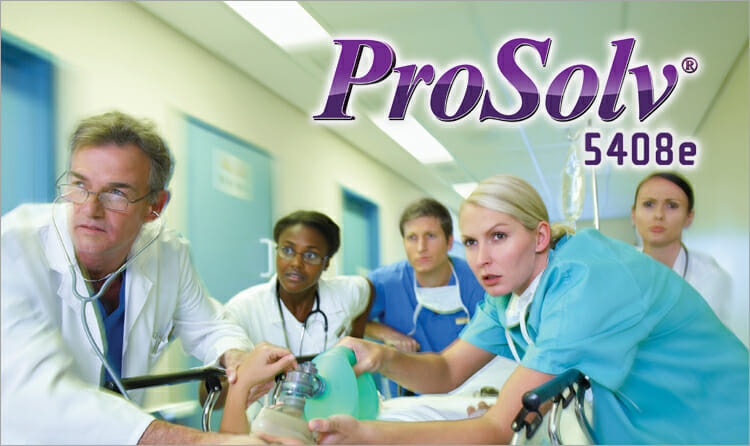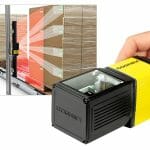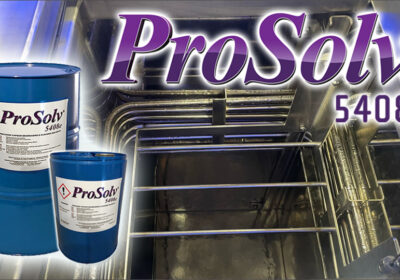The ongoing pandemic has increased the demand for critical cleaning of oxygen components and services to treat patients with the Covid-19 symptoms. The need for respirators and installation of new and extended oxygen systems in hospitals, clinics and care homes with the provision of ancillary pressure reduction and delivery systems has led to a massive increase in demand for the valves, fittings and pipelines which control the supplies from storage tanks and cylinders, all of which need critical cleaning.
ProSolv®5408e is a sustainable zero OPD and zero GWP solvent blend for high performance critical cleaning. This new solvent ticks all the boxes with the perfect profile for a vapour degreasing solvent.
ProSolv®5408e lower boiling point, economical with energy and low solvent losses, faster production, reduced costs, easy handling. Exceptionally low surface tension to penetrate micron sized holes and close contact surfaces.
High KB value for removal of organic residues, compatible with organic and synthetic oils and most plastics and metals, non-flammable, with zero ozone depletion (ODP) and global warming potential (GWP).
ProSolv®5408e is the perfect replacement for trichloroethylene, nPB (n-propyl bromide), perchloroethylene or flammable solvents used in general engineering cleaning processes.
THE SOLVENT OF CHOICE FOR CRITICAL CLEANING
ProSolv®5408e has a unique range of characteristics make it the solvent of choice for critical cleaning applications such as oxygen components and service line cleaning, aircraft avionics and aerospace parts and servicing, precision optics, medical and high vacuum components and electronics.
ProSolv®5408e can be used in most solvent cleaning systems, one tank vapour degreasing or multi tank immersion / vapour tank systems using ultrasonics or flush cleaning for complex mechanical and electronic components with blind holes and channels and close mounted electronics or for removing grinding and buffing soils on surfaces.
ProSolv®5408e is soft on the environment and safer for users. High performance, improved cleaning, lower costs. Sustainable and secure for future use as your forever solvent.
COMPONENT CLEANING FOR OXYGEN SERVICE
Cleaning for oxygen service is best defined as the removal of combustible contaminants from the surface of any equipment or system in oxygen service. Essentially, any component that may encounter an oxygen rich environment.
The combustible contaminants include organic and inorganic substances such as hydrocarbon material for example oils and greases, paper, fibre, dust, and soils. If these contaminants are not removed properly, in a worst-case scenario, this can cause combustion or explosion in an oxygen atmosphere or at the least rejection of the product due to unacceptable product purity.
Oxygen is not flammable, but it supports combustion. Oxygen can react with most materials. The higher the oxygen content and/or pressure in a system the more vigorous the combustion and the lower the ignition temperature required. Materials that do not normally ignite in air will burn and may explode in an oxygen rich environment. In addition, the oxygen rich environment will give rise to a higher flame temperatures and combustion velocity with potentially devastating consequences.
The recognition of oxygen’s reactivity has led to stringent requirements regarding the cleanliness of equipment in oxygen service. Strict guidelines exist to ensure that care must be taken in the selection of equipment including all materials and components, which all need to be oxygen compatible. They must also be free from combustible contaminants as described above.
Special consideration must be given to any cleaning processes employed in the manufacture and maintenance of all components of oxygen service systems. There are many options depending on the type of contaminants from aqueous to semi aqueous and blasting systems to remove welding slag etc. These are all referenced in the publications in the addendum below and we refer particularly in this article to the European Industrial Gases Assn (EIGA) DOC 32 4.3.1.2 Solvent Cleaning.
Solvent cleaning offers huge benefits in cleaning processes. ProSolv®5408e our NEW sustainable solvent is especially relevant for this use. Energy saving, totally recyclable, environment friendly zero ODP and GWP and safe for operators. High output, very fast process times, non-flammable, an excellent solvent for all the oils, greases and other organics which need to be removed after manufacturing processes and it is compatible with all types of metals and equipment, from immersion cleaning in simple multi tank counter current processes to integrated vapour and vapour liquid tanks with and without ultrasonics. EnviroTech Europe have extensive partnerships with equipment manufacturers through our distributors worldwide and information and advice on solvents and solvent systems and which need to be considered Some of these are discussed below.
Specific consideration must be given to the following:
· Cleaning standard to be achieved (how clean is clean?)
· Cleaning procedure
· Solvent cleaner to be used.
· Surface properties of the parts to be cleaned.
· Shape and geometry of the material
· Types and amounts of contaminants.
· The degree of automation required.
The size and capacity of the equipment is determined by:
- The size of the material or components to be cleaned.
- The required throughput.
Your starting point should be the cleaning standard and procedure. Solvent cleaning and solvent vapour phase cleaning of components consists of the removal of contaminants by immersion in the solvent, possibly with the addition of ultrasonic agitation and the action of continued condensation of solvent vapour on the component surfaces. The procedure requires that the oxygen equipment, system or component is colder than the solvent boiling point. This allows the vapour to condense on the components and perform a final rinse.
The major significant advantage of solvent cleaning is that vaporised solvent is always pure, and the contaminants remain in the boiling liquid section which requires only periodic cleaning out, thus causing a reduction in the frequency of system downtime.
The effectiveness of a particular cleaning agent depends upon the method by which it is used, the nature and type of the contaminants and the characteristics of the article being cleaned, such as size, shape, and material. Final evaluation of the cleaning agent should include testing of actual products and production processes.
All equipment must, together with the cleaning chemistry, comply as a minimum with current legislation for health, safety and environment. The efficiency is controlled by utilising typical samples, written procedures and requested criteria for cleanliness.
INDUSTRY STANDARDS FOR CLEANING OF EQUIPMENT AND COMPONENTS
As part of the programme of worldwide harmonisation of industry standards, the European Industrial Gases Association, (EIGA) has published EIGA Doc 33-18, Cleaning of Equipment for Oxygen Service. The publication was developed from the Compressed Gas Association Document G-4.1 Cleaning Equipment for Oxygen Service and the EIGA Document, Doc 33 Cleaning of Equipment for Oxygen Service. For information see EIGA’s website.
FURTHER INFORMATION
Please visit our website https://www.envirotech-europe.com/prosolv5408e for information about other uses and applications for ProSolv®5408e.
Visit www.envirotech-europe.com/applications-and-case-studies for information about uses and applications for all EnviroTech Europe products.
For more advice, please telephone us on +44 (0) 20 8281 6370 or use our website contact form.
All products are supplied and supported by EnviroTech Europe Ltd. Manufactured in the United Kingdom and available on short delivery times through our dedicated team of distributors worldwide.
supplied and supported by

Aissela, 46 High Street, Esher, Surrey, KT10 9QY,EnviroTech Europe Ltd
United Kingdom
Tel +44 (0) 20 8281 6370
www.envirotech-europe.com | contact@envirotech-europe.com







